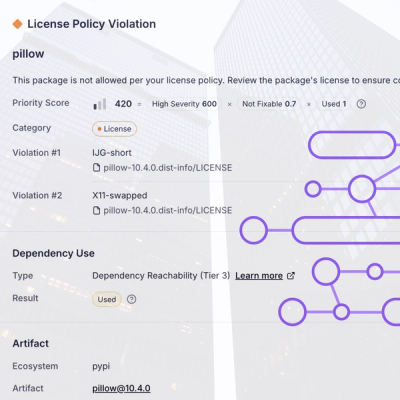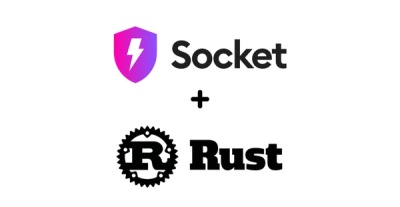
Research
/Security News
Critical Vulnerability in NestJS Devtools: Localhost RCE via Sandbox Escape
A flawed sandbox in @nestjs/devtools-integration lets attackers run code on your machine via CSRF, leading to full Remote Code Execution (RCE).
telegram-formatting
Advanced tools
telegram-formatting can help you format Telegram bot messages.
npm i telegram-formatting
You can use telegram-formatting to format messages, escape special characters, and convert special entities to formatted text and vice versa.
You can use Markdown-style or HTML-style formatting.
Note that entities must not be nested; and that escaping inside entities is not allowed, so an entity must be closed first and reopened again.
const { PARSE_MODES, mdv1, newlines } = require('telegram-formatting')
// import { PARSE_MODES, mdv1, newlines } from 'telegram-formatting'
const text = [
mdv1.bold('_bold_'),
// mdv1.bold('2 * 2 = 4'), // will fail
mdv1.b('2 ') + mdv1.escape('*') + mdv1.b(' 2 = 4'),
mdv1.italic('*italic*'),
// mdv1.italic('snake_case'), // will fail
mdv1.i('snake') + mdv1.escape('_') + mdv1.i('case'),
mdv1.link('*_link_*', 'http://www.example.com/'),
mdv1.link('link with ‘\\’', 'http://www.example.com/\\'),
mdv1.bold('link with ‘)’ will fail'),
mdv1.mention('*_mention_*', 123456789),
mdv1.blockquote('*_just plain text_*'),
mdv1.code('code'),
mdv1.pre('code block'),
mdv1.pre('console.log("javascript code block")', 'javascript')
].join(newlines())
Note that custom emoji entities can only be used by bots that purchased additional usernames on Fragment.
const { PARSE_MODES, html, newlines } = require('telegram-formatting')
// import { PARSE_MODES, html, newlines } from 'telegram-formatting'
const text = [
html.bold('<bold>'),
html.strong('<strong>'),
html.italic('<italic>'),
html.emphasis('<emphasis>'),
html.em('<also emphasis>'),
html.underline('<underline>'),
html.b(html.i(html.u('<bold italic underline>'), false), false),
html.inserted('<inserted>'),
html.ins('<also inserted>'),
html.strikethrough('<strikethrough>'),
html.strike('<also strikethrough>'),
html.deleted('<deleted>'),
html.del('<also deleted>'),
html.spoiler('<spoiler>'),
html.telegram_spoiler('<telegram spoiler>'),
html.text_link('<link>', 'http://www.example.com/'),
html.text_mention('<mention>', 123456789),
html.custom_emoji('👍', 5368324170671202286),
html.blockquote('<blockquote first line>\n' +
'<blockquote second line>\n' +
'<blockquote third line>\n' +
'<blockquote fourth line>'),
html.blockquote('<expandable blockquote first line>\n' +
'<expandable blockquote second line>\n' +
'<expandable blockquote third line>\n' +
'<expandable blockquote fourth line>', true),
html.code('<code>'),
html.pre('<code block>'),
html.pre('true && console.log("javascript code block")', 'javascript')
].join(newlines())
Note that in case of ambiguity between italic and underline entities, __ is always greadily treated from left to right.
const { STYLES, md, ln } = require('telegram-formatting')
// import { STYLES, md, ln } from 'telegram-formatting'
const text = [
md.b('*bold*'),
md.i('_italic_'),
md.u('__underline__'),
// md.b(md.i(md.u('*_bold italic underline_*'), 0), 0), // will fail
md.b(md.i(md.b('') + md.u('*_bold italic underline_*'), false), false),
md.s('~strikethrough~'),
md.spoiler('||spoiler||'),
md.link('[website](link)', 'http://www.example.com/'),
md.link('website link with ‘\\’', 'http://www.example.com//\\'),
md.link('website link with ‘)’', 'http://www.example.com/()'),
md.mention('[user](mention)', 123456789),
md.emoji('👍', 5368324170671202286),
md.quote('>blockquote first line\n' +
'>blockquote second line\n' +
'>blockquote third line\n' +
'>blockquote fourth line'),
md.quote('>expandable blockquote first line\n' +
'>expandable blockquote second line\n' +
'>expandable blockquote third line\n' +
'>expandable blockquote fourth line||', true),
md.code('`code`'),
md.pre('```code block```'),
md.pre('true && console.log("```javascript code block```")', 'javascript')
].join(ln())
You can use .escape() methods to escape special characters.
.escape(
string text,
array|true characters_to_be_excluded = [ ],
boolean must_escape = true,
array the_only_characters_to_be_escaped = [ ]
)
Use mdv1.escape() to escape special characters outside of entities.
const { mdv1 } = require('telegram-formatting')
// import { mdv1 } from 'telegram-formatting'
const text = mdv1.escape('[*_`just plain text`_*]')
Use html.escape() to replace special characters with HTML entities.
const { html } = require('telegram-formatting')
// import { html } from 'telegram-formatting'
const text = html.escape('<& just plain text &>')
Use md.escape() to escape special characters anywhere in the message.
const { md } = require('telegram-formatting')
// import { md } from 'telegram-formatting'
const text = md.escape('([{ \\~_=/ | `_> just plain text -_* ! \\+_#/ }])')
You can also escape Markdown-formatted text, which may contain ‘*’, ‘_’, ‘__’, ‘~’, ‘||’ and ‘`’ special characters.
const { md } = require('telegram-formatting')
// import { md } from 'telegram-formatting'
const text = md.escape('*Hello!*\n\n' +
'Have you __had to__ ~escape _special characters_~ in your locale file?\n' +
'Guess what? ||You need to do it no longer!||\n' +
'Now you can use regular Markdown text alongside ‘\\*’, ‘\\_’, etc.', true)
If you need to unescape special characters, you can.
const { mdv1, html, mdv2 } = require('telegram-formatting')
// import { mdv1, html, mdv2 } from 'telegram-formatting'
const mdv1Text = '[*_`just plain text`_*]'
const htmlText = '<& just plain text &>'
const mdv2Text = '([{ \\~_=/ | `_> just plain text -_* ! \\+_#/ }])'
const mdv1TextEscaped = mdv1.escape(mdv1Text)
const htmlTextEscaped = html.escape(htmlText)
const mdv2TextEscaped = mdv2.escape(mdv2Text)
console.log(mdv1Text === mdv1.unescape(mdv1TextEscaped)) // true
console.log(htmlText === html.unescape(htmlTextEscaped)) // true
console.log(mdv2Text === mdv2.unescape(mdv2TextEscaped)) // true
You can convert special entities to formatted text and vice versa.
const { mdv1, html, mdv2 } = require('telegram-formatting')
// import { mdv1, html, mdv2 } from 'telegram-formatting'
const message // telegram message
const results = [
mdv1.from_entities(message),
html.from_entities(message),
mdv2.from_entities(message),
]
// [ { [ text | caption ]: [ formatted text ] } ]
const { mdv1 } = require('telegram-formatting')
// import { mdv1 } from 'telegram-formatting'
const text = 'bold\nitalic\nlink\nmention\ncode\npre\nformatted'
const entities = [
{ offset: 0, length: 4, type: 'bold' },
{ offset: 5, length: 6, type: 'italic' },
{
offset: 12,
length: 4,
type: 'text_link',
url: 'http://www.example.com/'
},
{
offset: 17,
length: 7,
type: 'text_mention',
user: { id: 123456789 }
},
{ offset: 25, length: 4, type: 'code' },
{ offset: 30, length: 3, type: 'pre' },
{ offset: 34, length: 9, type: 'pre', language: 'markup' }
]
const result = mdv1.from_entities(text, entities)
// { [ text | caption ]: [ formatted text ] }
const { html } = require('telegram-formatting')
// import { html } from 'telegram-formatting'
const text = 'bold\nitalic\nunderline\n' +
'strikethrough\nspoiler\nlink\nmention\ncode\n' +
'b\nl\no\nc\nk\nq\nu\no\nt\ne\npre\nformatted'
const entities = [
{ offset: 0, length: 5, type: 'bold' },
{ offset: 5, length: 7, type: 'bold' },
{ offset: 5, length: 7, type: 'italic' },
{ offset: 12, length: 9, type: 'bold' },
{ offset: 12, length: 9, type: 'italic' },
{ offset: 12, length: 9, type: 'underline' },
{ offset: 22, length: 13, type: 'strikethrough' },
{ offset: 36, length: 7, type: 'spoiler' },
{
offset: 44,
length: 4,
type: 'text_link',
url: 'http://www.example.com/'
},
{
offset: 49,
length: 7,
type: 'text_mention',
user: { id: 123456789 }
},
{ offset: 57, length: 4, type: 'code' },
{ offset: 62, length: 9, type: 'blockquote' },
{ offset: 72, length: 9, type: 'expandable_blockquote' },
{ offset: 82, length: 3, type: 'pre' },
{ offset: 86, length: 9, type: 'pre', language: 'markup' }
]
const result = html.from_entities(text, entities)
// { [ text | caption ]: [ formatted text ] }
const { md } = require('telegram-formatting')
// import { md } from 'telegram-formatting'
const text = 'bold\nitalic\nunderline\n' +
'strikethrough\nspoiler\nlink\nmention\ncode\n' +
'b\nl\no\nc\nk\nq\nu\no\nt\ne\npre\nformatted'
const entities = [
{ offset: 0, length: 5, type: 'bold' },
{ offset: 5, length: 7, type: 'bold' },
{ offset: 5, length: 7, type: 'italic' },
{ offset: 12, length: 9, type: 'bold' },
{ offset: 12, length: 9, type: 'italic' },
{ offset: 12, length: 9, type: 'underline' },
{ offset: 22, length: 13, type: 'strikethrough' },
{ offset: 36, length: 7, type: 'spoiler' },
{
offset: 44,
length: 4,
type: 'text_link',
url: 'http://www.example.com/'
},
{
offset: 49,
length: 7,
type: 'text_mention',
user: { id: 123456789 }
},
{ offset: 57, length: 4, type: 'code' },
{ offset: 62, length: 9, type: 'blockquote' },
{ offset: 72, length: 9, type: 'expandable_blockquote' },
{ offset: 82, length: 3, type: 'pre' },
{ offset: 86, length: 9, type: 'pre', language: 'markup' }
]
const result = md.from_entities(text, entities)
// { [ text | caption ]: [ formatted text ] }
const { mdv1, html, mdv2 } = require('telegram-formatting')
// import { mdv1, html, mdv2 } from 'telegram-formatting'
const message // telegram message
const results = [
mdv1.to_entities(message),
html.to_entities(message),
mdv2.to_entities(message),
]
/*
[
{
[ text | caption ]: [ plain text ],
[ entities | caption_entities ]: [ [ special entities ] ]
}
]
*/
const { mdv1 } = require('telegram-formatting')
// import { mdv1 } from 'telegram-formatting'
const text = '*bold*\n_italic_\n' +
'[link](http://www.example.com/)\n' +
'[mention](tg://user?id=123456789)\n' +
'`code`\n```pre```\n```markup\nformatted```'
const result = mdv1.to_entities(text)
/*
[
{
[ text | caption ]: [ plain text ],
[ entities | caption_entities ]: [ [ special entities ] ]
}
]
*/
const { html } = require('telegram-formatting')
// import { html } from 'telegram-formatting'
const text = '< b >bold< / b >\n' +
'< strong >strong< / strong >\n' +
'< i >italic< / i >\n' +
'< em >emphasis< / em >\n' +
'< u >underline< / u >\n' +
'< ins >inserted< / ins >\n' +
'<b>bold <i>italic <u>underline</u></i></b>\n' +
'< s >strikethrough< / s >\n' +
'< strike >strike< / strike >\n' +
'< del >deleted< / del >\n' +
'< span class = "tg-spoiler" >spoiler< / span >\n' +
'< tg-spoiler >telegram spoiler< / tg-spoiler >\n' +
'< a href = "http://www.example.com/" >link< / a >\n' +
'< a href = "tg://user?id=123456789" >mention< / a >\n' +
'< tg-emoji emoji-id = "5368324170671202286" >👍< / tg-emoji >\n' +
'< code >code< /code >\n' +
'< blockquote >b\nl\no\nc\nk< / blockquote >\n' +
'< blockquote expandable >q\nu\no\nt\ne< / blockquote >\n' +
'< pre >pre< / pre >\n' +
'< pre >< code class = "language-markup" >formatted< / code >< / pre >'
const result = html.to_entities(text)
/*
[
{
[ text | caption ]: [ plain text ],
[ entities | caption_entities ]: [ [ special entities ] ]
}
]
*/
const { md } = require('telegram-formatting')
// import { md } from 'telegram-formatting'
const text = '*bold*\n' +
'_italic_\n' +
'__underline__\n' +
'*bold _italic __underline___*\n' +
'~strikethrough~\n' +
'||spoiler||\n' +
'[link](http://www.example.com/)\n' +
'[mention](tg://user?id=123456789)\n' +
'\n' +
'`code`\n' +
'>b\n>l\n>o\n>c\n>k\n' +
'**>q\n>u\n>o\n>t\n>e||\n' +
'```pre```\n' +
'```markup\nformatted```'
const result = md.to_entities(text)
/*
[
{
[ text | caption ]: [ plain text ],
[ entities | caption_entities ]: [ [ special entities ] ]
}
]
*/
You can use .to_entities() with stored user contents as well.
.to_entities(
string your_text,
string|null user_text = null,
array|null user_text_entities = [ ]
)
const { md, ln } = require('telegram-formatting')
// import { md, ln } from 'telegram-formatting'
const text = '*bold*\n' +
'_italic_\n' +
'__underline__\n' +
'*bold _italic __underline___*\n' +
'~strikethrough~\n' +
'||spoiler||\n' +
'[link](http://www.example.com/)\n' +
'[mention](tg://user?id=123456789)\n' +
'\n' +
'`code`\n' +
'>b\n>l\n>o\n>c\n>k\n' +
'**>q\n>u\n>o\n>t\n>e||\n' +
'```pre```\n' +
'```markup\nformatted```'
const userText = 'My name is Anatoly'
const userTextEntities = [ {
offset: 0,
length: 18,
type: 'bold'
} ]
const result = md.to_entities(
text,
userText + ln(2),
userTextEntities
)
/*
[
{
[ text | caption ]: [ plain text ],
[ entities | caption_entities ]: [ [ special entities ] ]
}
]
*/
Contributions are only allowed in TON:
UQCYqT9-ycmXE3o57Cac1sM5ntIKdjqIwP3kzWmiZik0VU_b
FAQs
telegram formatting
The npm package telegram-formatting receives a total of 0 weekly downloads. As such, telegram-formatting popularity was classified as not popular.
We found that telegram-formatting demonstrated a healthy version release cadence and project activity because the last version was released less than a year ago. It has 0 open source maintainers collaborating on the project.
Did you know?

Socket for GitHub automatically highlights issues in each pull request and monitors the health of all your open source dependencies. Discover the contents of your packages and block harmful activity before you install or update your dependencies.

Research
/Security News
A flawed sandbox in @nestjs/devtools-integration lets attackers run code on your machine via CSRF, leading to full Remote Code Execution (RCE).

Product
Customize license detection with Socket’s new license overlays: gain control, reduce noise, and handle edge cases with precision.

Product
Socket now supports Rust and Cargo, offering package search for all users and experimental SBOM generation for enterprise projects.